
2015.2 | 2015.1 | 2014.2 | 2014.1
2013.2 | 2013.1 | 2012.2 | 2012.1 | 2011.2 | 2011.1 | 2010.2 | 2010.1
2009.2 | 2009.1 | 2008.2 | 2008.1 | 2007.2 | 2007.1 | 2006
February – June 2007
- June 2007 Newsletter – May 27
- April 2007 Newsletter – April 3
- February 2007 Newsletter – February 1
June 2007 Newsletter
Shows and Exhibitions
- Sainte-Marie-aux-Mines – June 21–24, 2007
- Dallas Fine Mineral Show Recap
- Flashes of Colour: Stones and Wines of Legend – Jun.–Dec. 2007
Pala International News
Minerals and Mineralogy News
Books
Shows and Exhibitions
Sainte Marie aux Mines – June 21–24, 2007
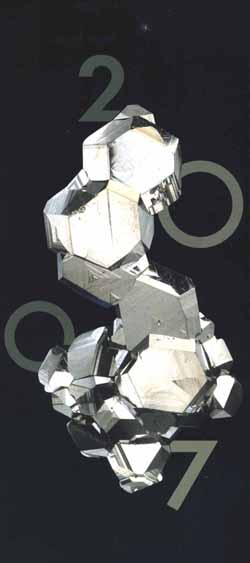 |
Minerals, Fossils, Gems, and Jewelry
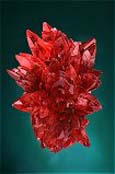 |
Pala International’s Bill Larson attends this event every year, held in the midst of the Alsace wine region of northeastern France. See his report from the 2006 show. And don’t miss Jeff Scovil’s photos of Bill’s collection on the Ste.-Marie website [since removed]—like the rhodochrosite from South Africa, pictured at right.
What: Euro-Mineral/Euro-Gem
When: June 21–24, 2007
Where: Sainte-Marie-aux-Mines, France
Bill looks forward to seeing you there. Visit the Pala International Show Schedule for future events. [back to top]
Dallas Fine Mineral Show Recap
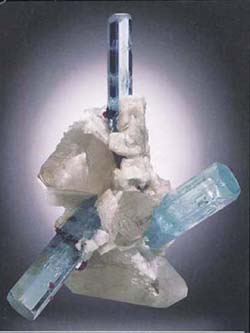 |
The first annual Dallas Fine Mineral Show, held May 4–7, was a real treat for those who attended. The show was set on the second floor of the Embassy Suites Hotel overlooking an open courtyard, with a view of trees and a little pond (with the resident swans Baron and Queen). Situating the dealers on one level allowed collectors and mineral enthusiasts to wander the pleasant open balcony and easily browse the exhibits set up in every suite. In this user-friendly environment there was plenty of space to interact and explore wherever your curiosity might lead you.
The lineup of dealers included some of the top names in the mineral world, selected by show coordinator Dave Waisman to create a well-polished conglomerate of characters. A superb assortment of mineral ikons and classics (to use Wayne Thompson’s terms), and new arrivals were on tap, as well as an excellent array of fossils for the creature-lovers. Reviews from dealers were mixed, but looking towards the future there was a general consensus that the show carries potential. [back to top]
“Flashes of Colour: Legendary Wines and Gemstones”
Pala Exhibits Eighty Gems and Minerals in Dijon, France
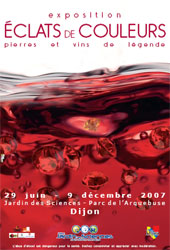 |
Bill Larson and Pala International have been asked to contribute approximately $1 million worth of gems and mineral specimens to an exhibition with the intriguing title, “Flashes of Colour: Stones and Wines of Legend,” to be held in the Sciences Garden at the Parc de l’Arquebuse, Dijon, France. The show, which runs from June 29 through December 9, 2007, compares the “true colors of wine... with the innumerable nuances offered by fine and invaluable stones.”
Included will be items from the French National Museum of Natural History, private collections, and national museums, as well as wines by the great vintners of Burgundy and beyond. In conjunction with the exhibition will be wine tastings, “experiments on light and color,” workshops on sensory perception, conferences, and more.
While this invitation is a distinct privilege for Pala’s Bill Larson, he also will be inducted into the Confrérie des Chevaliers du Tastevin (a wine tasters’ fraternity of the Burgundy region). This particular event, to be held on September 22, and thus called “Meeting of the Equinox and Precious Stones,” will be held at the Confrérie’s Château du Clos du Vougeot, a former Cistercian abbey. [back to top]
Pala International News
Pala’s Featured Mineral Specimen: Epidote
In this edition of Mineral News we feature a slender and exquisite epidote crystal from the historic Knappenwand Mine in Austria.
This epidote appears jet black and lustrous at first glance, but upon further examination evergreen hues start to shine through the translucent portions. This dark and intense specimen is in pristine form and is said to be the finest of its kind in private hands. Price upon request.
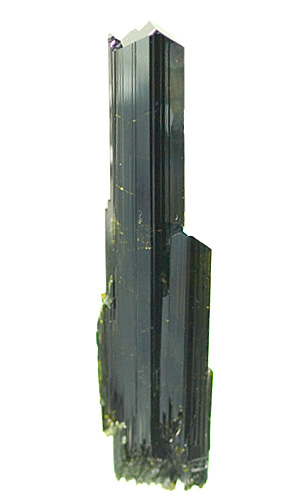 |
| Epidote Crystal, 11.8 x 2.8 x 1.2 cm. This specimen has been sold. (Photo: John McLean) |
The Knappenwand Mine near Neukirchen am Grossvenediger, in the state of Salzburg, Austria, is situated in the remote Tauern Alps. This locality was discovered by a mountain guide in 1865. The epidote specimens were described as the “most beautiful epidote crystals ever found” by Professor Victor Ritter Von Zepharovich of Charles University in Prague (Bancroft 1984). This epidote was reportedly mined in the late 1800s and has been carefully handed down through generations of mineral collectors. The original label has even been preserved (see below).
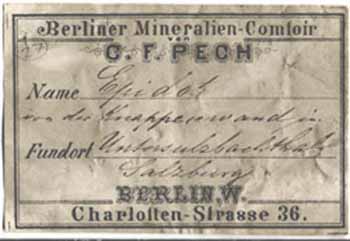 |
| Epidote label. Preserved mineral label circa late 1800s from Berliner Mineralien-Comtoir. |
Visit our mineral search for a selection of epidotes from around the world. [back to top]
Minerals and Mineralogy News
New Mineral Discovery
Look out, Superman, “Kryptonite” is Unearthed
Serbia turns out to be the earthly source for Superman’s elusive mineral nemesis. Geologists have discovered a white powdery substance that was tested by the Natural History Museum in London and Canada’s National Research Council. This mysterious mineral was found to have a chemical formula of sodium lithium boron silicate hydroxide, which seems to be a near match for the fictional mineral kryptonite as depicted in the film Superman Returns. (The fictional material also contains fluorine.) The new mineral is to be called jadarite, after the location of the Serbian mine (Jadar), and will be on display in London’s Natural History Museum. The large green crystals from Krypton that render Superman powerless now have a white counter part here on Earth; who could have imagined? [back to top]
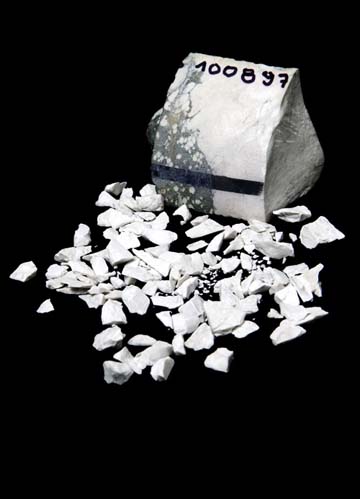 |
| “Kryptonite” in the raw. It looks harmless, but don’t be surprised when your powers are hindered. (Photo courtesy National Research Council Canada) |
Natural History Museum Acquires Massive Stibnite Specimen
George E. Harlow, Ph.D., Curator of Minerals and Gems at the American Museum of Natural History (AMNH), sent us the photo below of a remarkable half-ton stibnite specimen that was placed on display April 4. According to the AMNH website, “The unique specimen on display at the Museum was spared from destruction by alert miners in the Wuning (Wuling) antimony mine in Jiangxi Province of southeastern China. Stibnite is most commonly pulverized and heated to extract the antimony and make flame retardants and engine bearings.”
The specimen was donated by Mark Weill, a world-renowned mineral collector, who also received this year’s Paul E. Desautels Award at Tucson, according to The Mineralogical Record. It is the largest such specimen on public display in the world. [back to top]
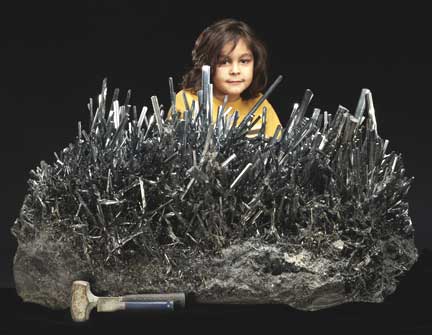 |
| Lost in a forest of stibnite. Children and adults alike can be inspired by such an awesome sight. (Photo courtesy American Museum of Natural History) |
Books
Highlight from Ikons, a book by Wayne A. Thompson
Kunzite Spodumene
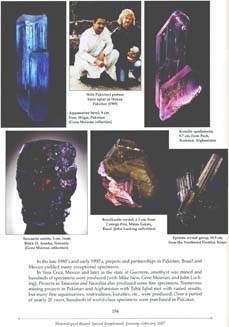 |
A beautiful kunzite specimen, pictured in Wayne Thompson’s book, Ikons: Classics and Contemporary Masterpieces of Mineralogy, is now in the Pala International collection. Pictured at right is page 184 from the book; the kunzite specimen can be seen in the top right corner.
This aesthetic beauty has a long slender crystal attached to a short and stocky crystal. This kunzite is from Pech, Nuristan, Afghanistan.
The title Ikons comes from Wayne Thompson’s explanation of categorizing world-class specimens. Thompson gives us the tools, guidelines, and insight into how to go about building a world class mineral collection. The following in a excerpt from the introduction:
Some specimens have an unforgettable visual presence, such that their images stay in the memory of the viewer. Some combine exceptional quality with important provenance and historical significance. Others, although collected too recently to be considered “historical,” are among the finest of their type. The common unifying factor is the exceptional quality of each piece, but the particular historical aspects and flavor, so to speak, of their aesthetic impacts can also serve to categorize them in meaningful ways. … I call these three main categories “ikons,” “classics,” and “contemporary masterpieces.”
Ikons is available through The Mineralogical Record.
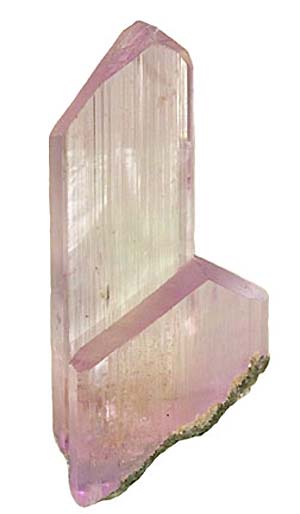 |
| Kunzite spodumene, 9.7 x 4.2 x 1.7 cm. (Photo by John McLean) |
See more details and pricing here. [back to top]
— End June Newsletter • Published 5/27/07 —
April 2007 Newsletter
Shows and Exhibitions
Pala International News
Minerals and Mineralogy News
- An Update on Alexandrite
- Honey, I Shrunk the Geologist
Books
Shows and Exhibitions
The 1st Annual Dallas Fine Mineral Show – May 4–6, 2007
 |
Visit Pala’s Roomful of Goodies (Suite 206)
 |
The 1st Annual Dallas Fine Mineral Show is an exclusive show highlighting 21 top mineral dealers. Pala International will be exhibiting superb collections of minerals that Bill Larson has assembled over the years. Old classics and some new specimens from recent finds will be on display.
Event Website: Dallas Fine Mineral Show
When: May 4–6, 2007
Where: Embassy Suites Dallas
Suite: 206
Contact: Dave Waisman, 509.458.2331
We look forward to seeing our many friends there. Visit the Pala International Show Schedule for future events. [back to top]
West Coast Gem & Mineral Show – May 18–20, 2007
 |
Several members of the Pala staff will attend this show. See you there!
Event: West Coast Gem & Mineral Show
When: May 18–20, 2007
Where: Holiday Inn – Bristol Plaza, Costa Mesa, CA
[back to top]
Pala International News
Pala’s Featured Mineral Specimen: Alexandrite
In this edition of Mineral News we feature an alexandrite sixling from the Griddlestone Claim in Zimbabwe.
The alexandrite specimen has a striking appearance with one well-formed sixling on one side and a partial larger spray on the other side. This dark and intense specimen even shows a good color change. The arms of the sixlings seem to penetrate throughout the entire specimen in etched terraces. Price upon request. See it for yourself in Dallas.
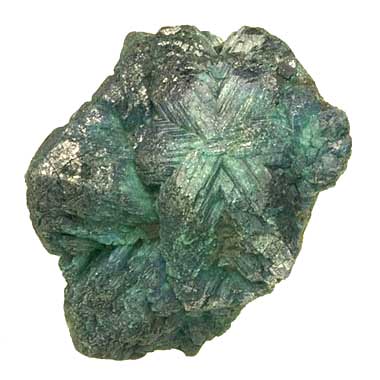 |
| Alexandrite specimen, 111.8 grams, 50.0 x 48 x 34 mm. This specimen has been sold. (Photo: John McLean) |
Visit our mineral search for a selection of alexandrites from around the world. [back to top]
Minerals and Mineralogy News
An Update on Alexandrite
Nikolai on Location
Nikolai Kouznetsov, partner and friend of the whole Pala crew, sends photos of his recent explorations in the Malysheva Mine in the Ural Mountains of Russia. The Malysheva Mine is located 98 km. northeast of Ekaterinburg (Sverdlovsk). This mine was established in 1833 as one of the world’s major emerald sources. The Tokovaya mines, which lie just to the south, are part of the same Ural Emerald Belt of rocks that was made famous by the discovery of alexandrite.
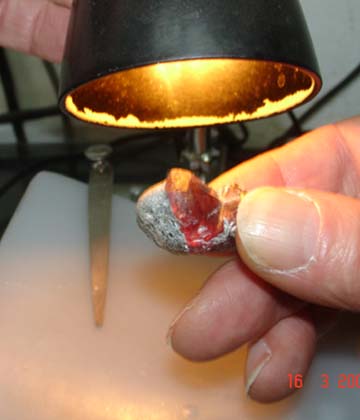 |
| Alexandrite crystal in situ exhibiting an intense red hue under incandescent light. Hopefully we will be seeing more of these beauties. (Photo courtesy of Nikolai Kouznetsov) |
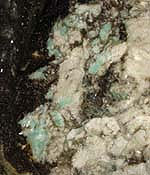 |
In general, the geology of this area is composed of a mica-schist rock type that is associated with a zone of metamorphism and pegmatite lenses. This belt of altered rock has produced amethyst, aquamarine, blue topaz, phenakite, chrysoberyl, emerald, and alexandrite.
Nikolai went down 260 meters into the mine, poking around and getting a feel for the potential of the mineral wealth. The mine operators are expecting lots of material to be processed and available by July. A very small percentage of the rock removed will yield mineral specimens or facetable rough. Nikolai would like to thank Graham Radburnd (operations manager of the mine), Jimmie Wilde (manager), and Warren Boyd for his mine visit.
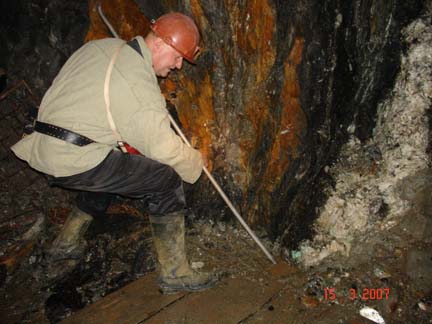 |
| Nikolai in his element. This photo shows the black-and-white mica-schist with hints of emerald near the end of the poking rod. (See close-up above right.) Notice the recent date, March 15, 2007. (Photo courtesy of Nikolai Kouznetsov) |
[back to top]
Alexandrite Around the World
From the original discovery and identification in the Ural mountain of Russia in 1830, the collector of phenomenal gemstones has seen new deposits pop up around the globe. This color-change variety of chrysoberyl has surfaced in India, Sri Lanka, Zimbabwe, Burma, Tanzania, Madagascar, and Brazil. Although localities seem to be growing, high quality rough with facetable sections that exhibit pure saturated colors are still extremely rare. Brazilian alexandrite seems to exhibit the most vivid colors while showing strong color change.
See Pala’s new selection of faceted Brazilian alexandrite here. See our assortment of alexandrite specimens here. See also our Alexandrite Buying Guide.
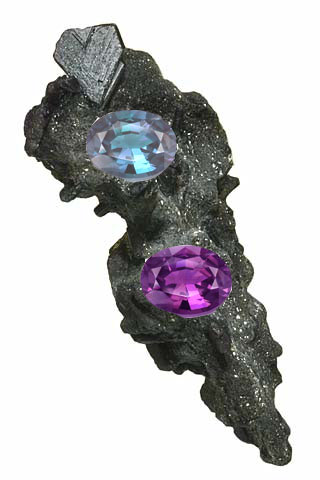 |
| Brazilian rough and cut. Faceted alexandrite showing a color change pair, superimposed on rough alexandrite specimen. Dark mica-shist body with a V twin shield alexandrite crystal extending out on top. |
[back to top]
Gübelin Research Project on Alexandrites and Chrysoberyls
From Gübelin Gem Lab Newsletter #17: Gem-quality alexandrites and chrysoberyls are now available from a large number of sources. This was not always the case. Methods of origin determination must keep pace with this increased supply. For this reason, the Gübelin Gem Lab (GGL) has initiated a research project to analyze and understand the properties of alexandrites and chrysoberyls from all commercially relevant sources worldwide. This project intends to maintain and enhance the service of origin determination for these gems in the future.
GGL newsletters are archived on the lab’s website, but #17 is not yet available. [back to top]
Honey, I Shrunk the Geologist
No, these are not shrunken spelunkers, and Superman’s Fortress of Solitude has not been infiltrated. These are actual humans in the company of uber-selenite crystals found deep within the earth’s crust in the state of Chihuahua in north-central Mexico.
We repeat: These photographs are completely real—no Photoshop involved.
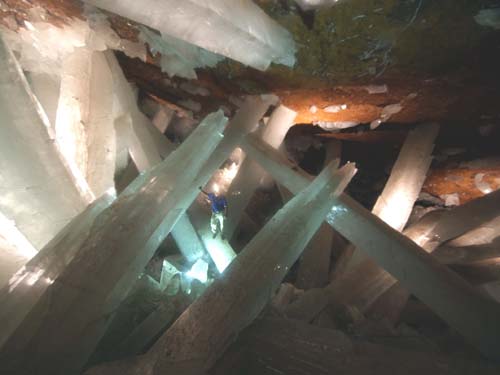 |
| Naica’s giant dreamscape. Just imagine what this miner will wake up tomorrow thinking about. (Photo: Source unknown) |
These spectacular oversized gem pockets were punctured in the pursuit of lead/zinc sulfide ore bodies in the Naica Mine (the largest lead mine in Mexico, operated by Industrias Peñoles), at a depth of 1200 feet below the surface. Entering the caves for longer than 5 minutes requires extra gear because the temperature is around 135 degrees Fahrenheit, with humidity over 90%. Heat is disseminated by a magma chamber that lies just 2–3 miles below the mine. Upon exploration of the caverns it became very apparent these were the largest free-standing crystals ever discovered. Amazingly, two crystal habits are shown: the long, columnar tree-sized formations and the radiating clusters with point terminations.
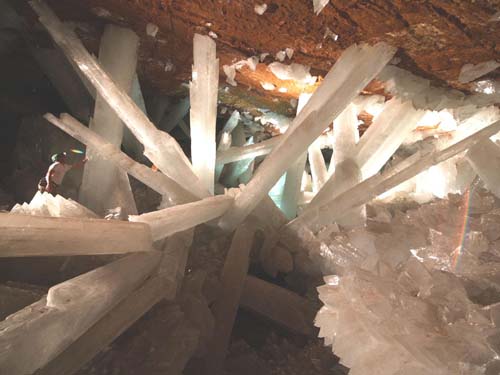 |
| Is this for real? This miner tested his theory by pinching a selenite crystal. (Photo: Source unknown) |
The mine has taken steps to preserve these caves intact, since collecting would be nearly impossible. Rumors are even circulating that tours may be available in a year, but this would be difficult since the selenite caves are within an active mining operation. Until then we can explore with our mind.
Read and see more on this out-of-this-world discovery:
- The Giant Crystal Project
- Naica Caves Website
- History of the Naica Crystal Caves
- Article from Geology, the journal of The Geological Society of America, April 2007
[back to top]
Books
Robbing the Sparry Garniture: A 200-Year History of British Mineral Dealers
Reviewed by William F. Larson
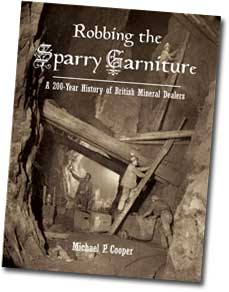 |
A new book appeared in Tucson this year, Robbing The Sparry Garniture: A 200-Year History of British Mineral Dealers, by Michael P. Cooper.
I highly recommend this fine history. Wonderfully researched, it is an obvious labor of love for the benefit of all of us in the mineral hobby. Through the first 68 pages the reader is given the scope of the book, the author’s sources, who qualified as a mineral dealer, distributors, etc. Then, starting on page 69, a directory of British mineral dealers, 1750–1950.
The writing is clear, concise, and often humorous. Mr. Cooper is a gifted writer who has a lot of knowledge to impart. The book is absolutely brilliant and well illustrated. It has great examples of various dealer’s labels that show why The Mineralogical Record has spent so much time documenting these “artifacts.” Kudos to Wendell Wilson and MinRec for publishing this wonderful book.
The title comes from a 1900s quote by F.W. Rudler (1840–1915):
The walls of these cavities are, in many cases, studded with crystals of quartz and other minerals for which the haematite mines have become famous. It is by robbing these cavities of their sparry garniture that we obtain those beautiful crystals which adorn our collections.
Available through The Mineralogical Record here.
The following photograph, taken from Robbing the Sparry Garniture, is in the introduction exhibiting how the collecting hobby can begin with a pretty face and a plateful of crystals.
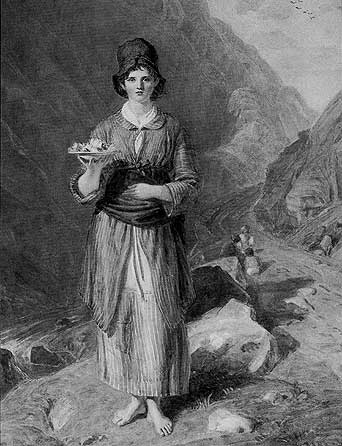 |
| Joshua Cristall (1768–1847) watercolor painting of a young Welsh girl selling quartz crystals by the roadside. Cristall is presumed to have painted this while touring north Wales and collecting from 1802–1803. Earliest depiction of mineral dealing in Great Britain. (Courtesy of Bolton Museum, Art Gallery and Aquarium) |
[back to top]
— End April Newsletter • Published 4/3/07 —
February 2007 Newsletter
Shows and Exhibitions
Pala International News
Books
Shows and Exhibitions
Tucson Time – January 31–February 11, 2007
 |
Make your plans for the world’s greatest gem and mineral show in February. Pala International will be represented, as follows:.
Event: AGTA Gem Fair
When: January 31–February 5, 2007
Where: Tucson Convention Center
Booth: 1016–1018
Event: Westward Look Mineral Show
When: February 2–6, 2007
Where: Westward Look Resort
Suite: 236
Website: Official show website
Event: 52nd Annual Tucson Gem and Mineral Show
When: February 8–11, 2007
Where: Tucson Convention Center
Booth: Aisle 5 East
We look forward to seeing our many friends there. Visit the Pala International Show Schedule for future events. [back to top]
The University of Arizona Mineral Museum and Flandrau Science Center
A New Mineral Exhibit in Tucson
 |
As if you didn’t have enough to do in Tucson, a new mineral exhibit, entitled “The Many Faces of Copper,” should be another sight to see. The exhibit will be held in the University of Arizona Mineral Museum, located on the lower level of the Flandrau Science Center. The grand opening of the new exhibit is February 2 and it will be on display thereafter.
A Tribute to Richard Bideaux (1935–2004)
 |
Also on display at the UA Mineral Museum is an exhibit featuring minerals and memorabilia from the collection of the late author and mineralogist Richard Bideaux, a founder of the Mineralogical Record. According to the exhibit webpage, contributors include Arizona-Sonora Desert Museum, the Geo-Literary Society, the GIA Library, Harvard Mineralogical Museum, Les and Paula Presmyk, and Phelps Dodge Mining Company. The exhibit runs through October 1, 2007. [back to top]
Pala International News
Pala’s Featured Mineral Specimen: The Mogok Castle
In this edition of Mineral News we feature a natural ruby crystal from Mogok, Burma.
The specimen is well formed and doubly terminated. This complex specimen has six well-formed sides with angular etching running throughout. This intense ruby is also intertwined with white calcite, which makes for a stark contrast with the deep red hue. Topping off this exquisite ruby castle, we find a shiny turret extending out from the main structure. Price upon request. See it for yourself in Tucson.
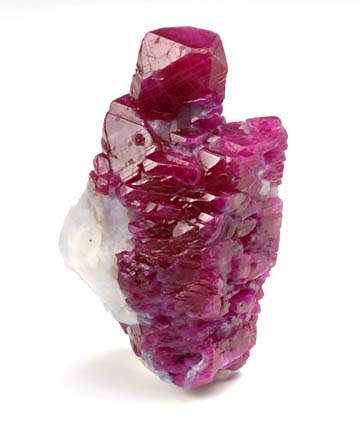 |
| The Mogok Castle, 81.2 grams, 56.0 x 26.5 x 23.8 mm. Seeing it for yourself... priceless. This specimen has been sold. (Photo: Wimon Manorotkul) |
The following passage has materialized through myth, from the Land of the Rubies.
Burmese Ruby Crystal... A glimpse of pigeon’s blood colour.
The Bedin-saya, who interpret dreams in shaded, scented corners of the markets, tell of Burmese ruby as different from Rubies in the rest of the world. One only needs to look to see, they say. Burma Ruby challenges credibility. Nature could not permit such a condensation of colour creating absolute Red; without theft and vacuum in the remainder of the world.... The true pigeon’s blood is more a colour of the mind than the material world. “Asking to see the pigeon’s blood is like asking to see the face of God.”
Red Beryl is Back
Pala’s Tucson Highlight
Gem-quality red beryl is really only found in the Wah Wah Mountains of southeast Utah. This variety of beryl is associated with a white volcanic rhyolite. The combination of red and white makes for some spectacular mineral specimens. To illustrate the rarity of fine quality specimens, it was reported that the Utah deposit yielded 0.5 ct. of facetable red beryl for every 1 ton of rock removed (Rex Harris 1976–1994). It was calculated elsewhere that every 1 ton of rock would yield 0.25 grams (1.25 ct.) of rough gem grade red beryl, of which 90% was lost in cutting, leaving a 0.125-ct. faceted gem (KEC 1996). To learn more on red beryl see Gems & Gemology (39:4, Winter 2003).
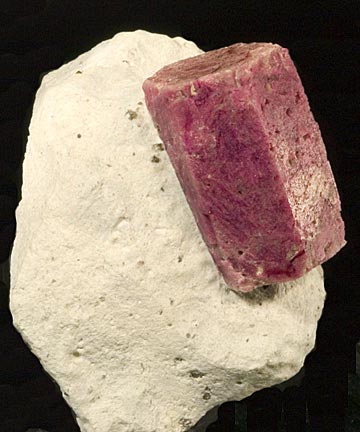 |
| Red beryl well formed doubly terminated crystal on rhyolite matrix. Opaque crystal with strawberries-and-cream type appearance. Dimensions: 30 x 19 mm. (Photo: John McLean) |
New at Pala. These two beauties were plucked from the top of the barrel, having the best and biggest crystals. The barrel does run pretty deep, however, so there are specimens ranging in all shapes, sizes, and quality; something for every level of collector.
The future mining of red beryl is uncertain, so this may be a good opportunity to acquire this endangered species. Samples will be on display at the Tucson Gem & Mineral Show (see show details above).
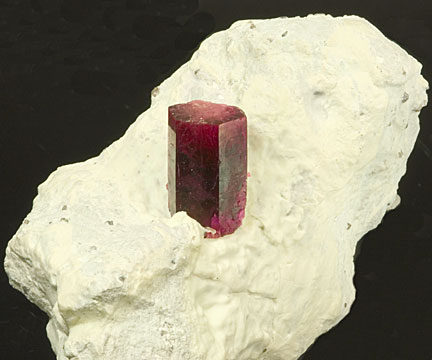 |
| Fine red beryl. This crystal is in excellent condition, with perfect hexagonal shape, translucent gemmy portions, and an intense cherry-red hue. Dimensions: 18 x 11 mm. (Photo: John McLean) |
Interested? See us in Tucson, email us, or give us a call. [back to top]
Pala’s New Secret
A new gem and mineral vault is nearing completion, set to showcase the “really good things” that have found their way into Pala’s collection. If you can find it, you are warned, “Abandon hope all ye who enter here.” It’s one hell of a collection!
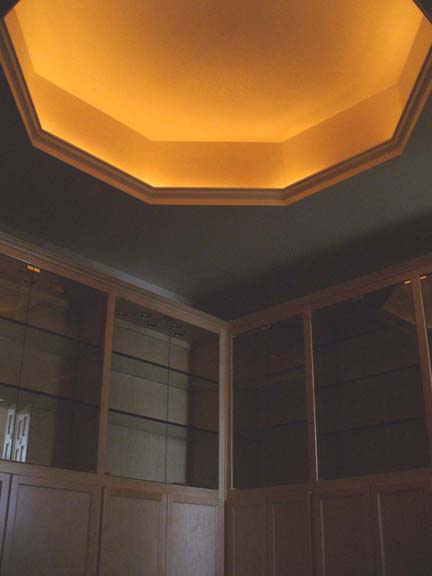 |
| The vault. A glimpse into the new hidden vault somewhere on the Pala International grounds. (Photo: Jason Stephenson) |
[back to top]
Books
Ikons: Classics and Contemporary Masterpieces of Mineralogy
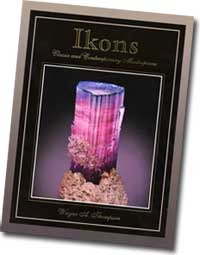 |
Wayne Thompson releases his new book, Ikons, as a soft cover supplement to the current issue of Mineralogical Record, as well as a special hard bound edition. It’s a colorful conglomeration of the world’s most famous mineral specimens. The book also provides the reader with a glimpse into the world of collecting, and thus it highlights minerals from the collecting era that can be traced back to the 16th century in Europe. Wayne catalogs the best examples from all the major mineral deposits, from the 1800s through the most recent finds. A well illustrated story of the collector’s "Ikons".
The book is available here.
The following photographs, taken from Ikons, are just a couple of the specimens with which Pala International’s Bill Larson has been personally involved.
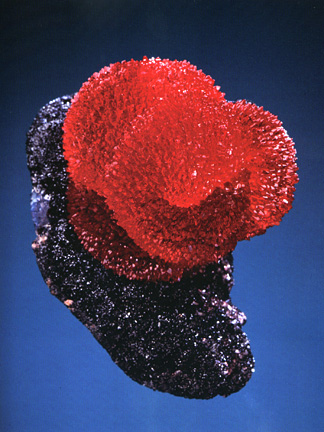 |
| Rhodochrosite on manganite. This famous specimen, aptly named “The Snail,” was acquired by Bill Larson in South Africa in 1976. (Photo: Jeffrey Scovil) |
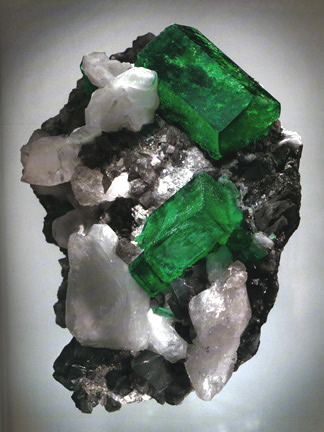 |
| Emerald with calcite. Collected in 1978 at the Cosquez mine in Colombia, this specimen is said to be one of the finest emeralds on matrix known. (Photo: Harold and Erica Van Pelt) |
[back to top]
— End February Newsletter • Published 2/1/07 —